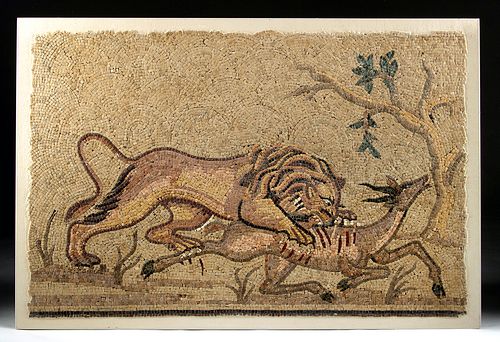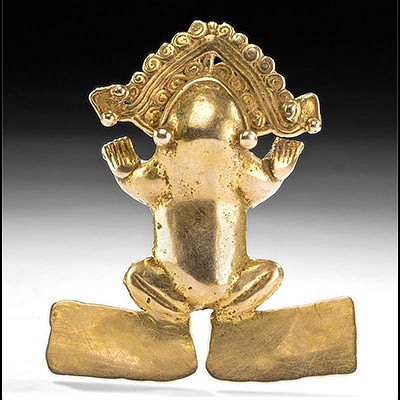Roman Stone Mosaic - Lion Hunting Prey
Lot 32a
About Seller
Artemis Fine Arts
686 S Taylor Ave, Ste 106
Louisville, CO 80027
United States
Selling antiquities, ancient and ethnographic art online since 1993, Artemis Gallery specializes in Classical Antiquities (Egyptian, Greek, Roman, Near Eastern), Asian, Pre-Columbian, African / Tribal / Oceanographic art. Our extensive inventory includes pottery, stone, metal, wood, glass and textil...Read more
Categories
Estimate:
$16,000 - $24,000
Absentee vs Live bid
Two ways to bid:
- Leave a max absentee bid and the platform will bid on your behalf up to your maximum bid during the live auction.
- Bid live during the auction and your bids will be submitted real-time to the auctioneer.
Bid Increments
| Price | Bid Increment |
|---|---|
| $0 | $25 |
| $300 | $50 |
| $1,000 | $100 |
| $2,000 | $250 |
| $5,000 | $500 |
| $10,000 | $1,000 |
| $20,000 | $2,500 |
| $50,000 | $5,000 |
| $100,000 | $10,000 |
| $200,000 | $20,000 |
About Auction
By Artemis Fine Arts
Aug 13, 2020
Set Reminder
2020-08-13 10:00:00
2020-08-13 10:00:00
America/New_York
Bidsquare
Bidsquare : Fine Antiquities, Ethnographic & Fine Art
https://www.bidsquare.com/auctions/artemis-gallery/fine-antiquities-ethnographic-fine-art-5415
Features classical antiquities, ancient and ethnographic art from cultures encompassing the globe. Egyptian, Greek, Roman, Etruscan, Near Eastern, Asian, Pre-Columbian, Native American, African / Tribal, Oceanic, Spanish Colonial, Russian, Fine Art, so much more! Artemis Fine Arts info@artemisgallery.com
Features classical antiquities, ancient and ethnographic art from cultures encompassing the globe. Egyptian, Greek, Roman, Etruscan, Near Eastern, Asian, Pre-Columbian, Native American, African / Tribal, Oceanic, Spanish Colonial, Russian, Fine Art, so much more! Artemis Fine Arts info@artemisgallery.com
- Lot Description
Roman, the Levant, late Imperial Period, ca. 3rd to 5th century CE. A terrifying scene depicting a ferocious lion digging his claws and taking a bite of his prey with his sharp fangs. The poor victim - perhaps a deer - is wrenching its neck, and with an open mouth likely howling in agony, its legs collapsing beneath to the ground marked by tufts of grass. The wild feline's body is dramatically pouncing upon the horned animal, his long tail raised and curled with excitement, the movement of his flowing mane reflecting the energy of the scene. All is delineated in square/rectangular tesserae of russet, sienna, chocolate brown, golden ochre, cocoa, rose, peach, black, green, and white against a creamy beige ground. Note how even the tesserae of the background are arranged in nested arches - further amplifying the sense of dynamism of the hunt. Size (mosaic): 45.6" W x 29.75" H (115.8 cm x 75.6 cm); (frame): 48.25" W x 32.3" H (122.6 cm x 82 cm)
Mosaics (opus tesellatum) are some of our enduring images from the Roman world, not only for their aesthetic beauty, but also because they reveal what Romans chose to depict and see every day decorating their private and public spaces. This piece at first glance seems quite simple - a lion hunting its prey. However, the symbolism of the iconography is layered and rich. In the classical world, lions symbolized power, wealth, and might. They were famously featured in many ancient myths, perhaps the most famous being that of Hercules (Greek Herakles) slaying the Nemean lion for his first labor. The lions fur was believed to be impenetrable to attacks since according to legend it was made of gold and its claws were far sharper than swords with the power to slice through armor. In the end, Hercules defeated the lion by strangling it and wore its skin.
Lions were also favorite iconography for buildings, coins, and statues. Examples include the Lion Gate to the Citadel of Mycenae, the Terrace of the Lions on the island of Delos, and the lion hunt mosaic from Pella featuring Alexander engaged in a lion hunt. Of course lions were also used in the Roman arenas where they would fight other animals, such as tigers and bears.
In the Roman province of Syria, which encompassed most of the ancient Near East/Levant, mosaics developed as a popular art form relatively late, with most finds coming from the 3rd century CE or later. Syria was one of Rome's wealthiest provinces, but it was also far removed from Rome itself and Roman culture was overlaid on enduring cultural traditions from Hellenistic Greece and the great civilizations that came before it. For example, Antioch-on-the-Orontes (modern day Antakya, Turkey), was the capital of northern Roman Syria, and its excavations in the 1930s revealed more than three hundred mosaic pavements.
Provenance: ex-Phoenicia Holland Antiquities, ex-Fortuna Art Gallery collected in the 1990s
All items legal to buy/sell under U.S. Statute covering cultural patrimony Code 2600, CHAPTER 14, and are guaranteed to be as described or your money back.
A Certificate of Authenticity will accompany all winning bids.
We ship worldwide and handle all shipping in-house for your convenience.
#157320Mounted on a concrete backing and framed. Small losses to some tesserae, with chips and encrustations to several tesserae, and a couple of stable hairline fissures to concrete backing, otherwise in great condition with beautiful preservation to zoomorphic imagery as well as tesserae coloration.Condition
- Shipping Info
-
All shipping is handled in-house for your convenience. Your invoice from Artemis Gallery will include shipping calculation instructions. If in doubt, please inquire BEFORE bidding for estimated shipping costs for individual items.
-
- Buyer's Premium



 EUR
EUR CAD
CAD AUD
AUD GBP
GBP MXN
MXN HKD
HKD CNY
CNY MYR
MYR SEK
SEK SGD
SGD CHF
CHF THB
THB






















